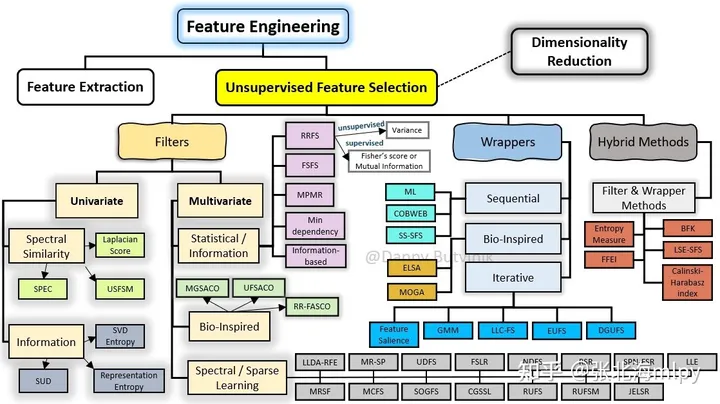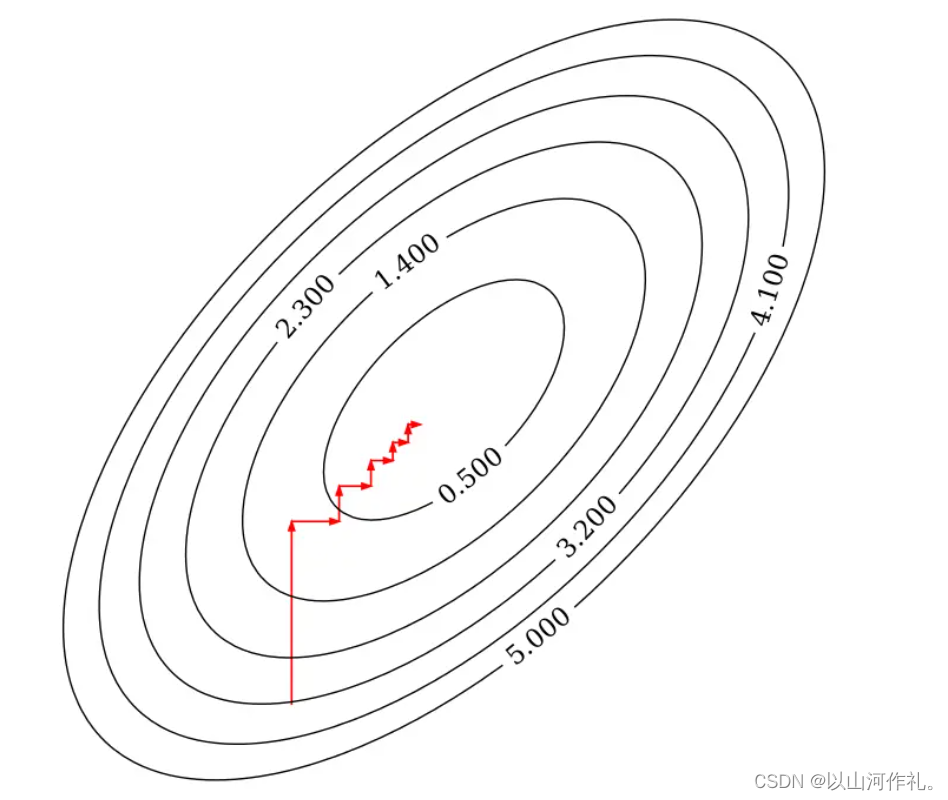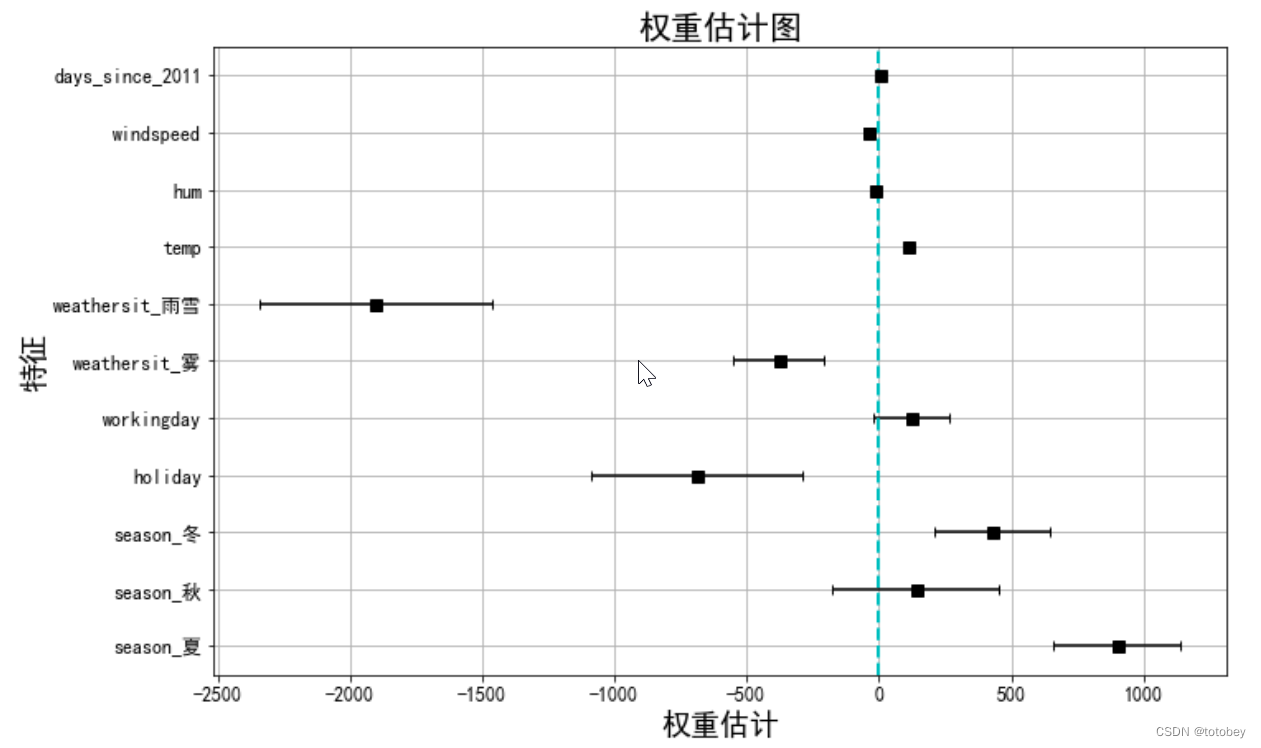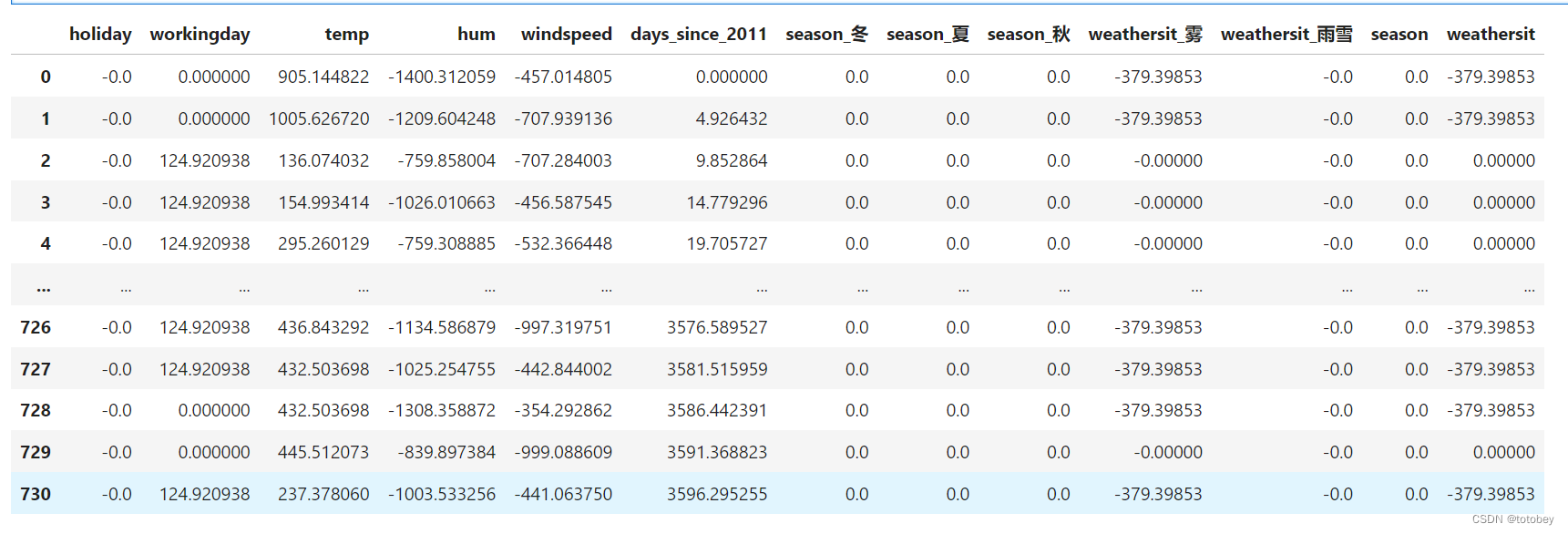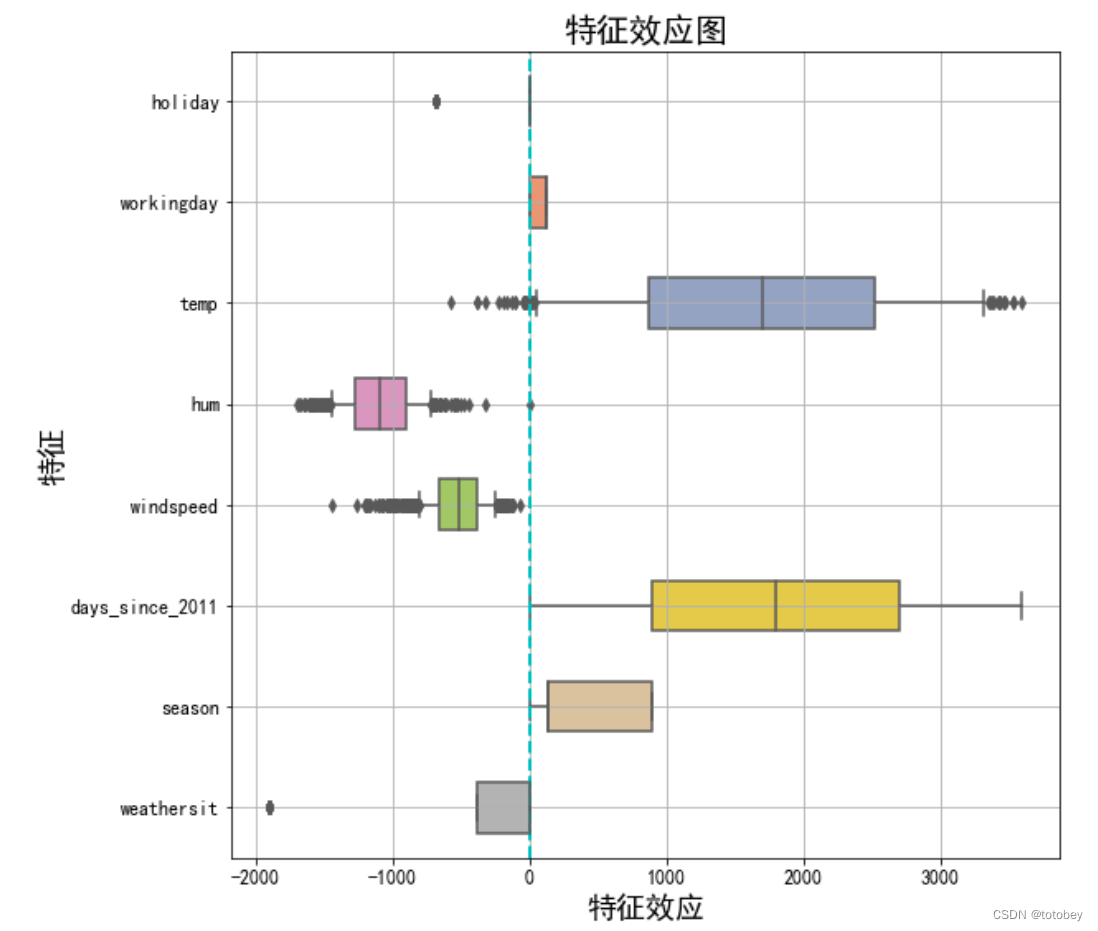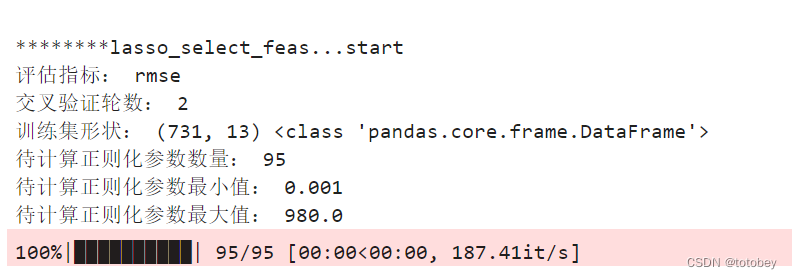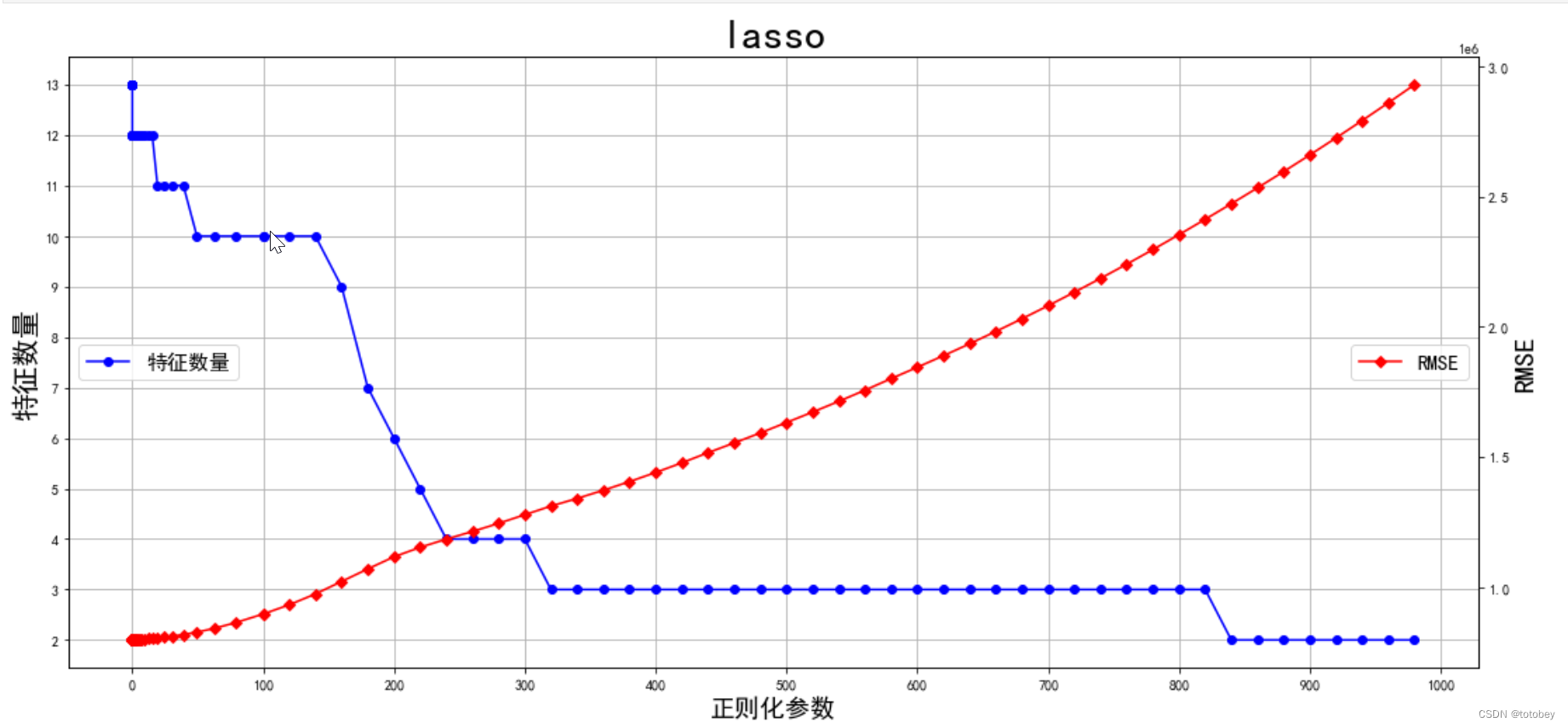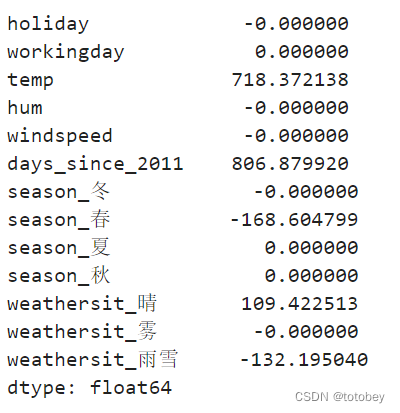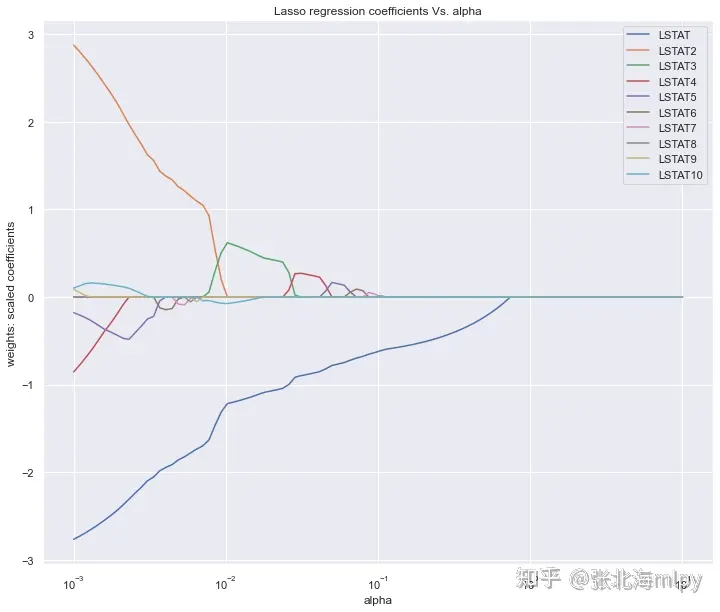[TOC]
转:https://blog.csdn.net/totobey/article/details/124994579
模型:多元线性回归
特征选择:LASSO特征选择
数据集:
X:输入特征分类特征处理方式:one-hot编码,未出现的取值作为参照类别 连续特征处理方式:原始值,未进行标准化和归一化 y:自行车租赁量 背景 特征选择是机器学习中很大的一个话题
why?当特征数量过多,传统的最小二乘法(Ordinary Least Squares, OLS)回归模型往往会得到过拟合的模型
特征之间存在多重共线性,会导致模型参数估计不稳定甚至无法计算 并非所有特征都对预测结果有显著影响,一些无关或冗余的特征可能会干扰模型的预测性能。 正则化 Ridge
ridge回归,无法直接剔除不重要特征,将不重要特征的回归系数趋于0,使其对预测值影响较小 L2正则能有效防止模型过拟合,解决非满秩情况下求逆困难问题 Lasso
lasso回归,将不重要特征的回归系数缩减为0,从而达到剔除的目的 L1正则,能够系数矩阵,在特征数庞大的情况下进行特征选择 lasso可用于特征选择,Ridge不可
LASSO优化目标是
上式不是连续可导的,因此常规的解法如梯度下降法、牛顿法、就没法用了。常用的方法:坐标轴下降法与最小角回归法 (Least-angle regression (LARS))。
坐标下降法 迭代优化算法,求解具有可分离结构的凸优化问题。常用于训练特征数量非常大的大规模线性模型
初始化权重向量w
迭代更新权重系数
在每次迭代过程中,依次更新每个权重系数 $w_m$ ,保持其他权重不变,对于第 $k$ 次迭代和第 $m$ 个权重系数,更新规则为
判断收敛性与迭代终止
如果所有权重系数变化非常小,或达到了预设的最大迭代次数,算法停止迭代
坐标下降法的优势在于其简单性和易于并行化 ,尤其适合于解决高维问题,因为每次更新一个变量时,不需要计算所有变量的信息。
然而,由于其更新规则的贪心性质,可能不保证全局最优解,特别是当损失函数非凸时。尽管如此,在实际应用中,坐标下降法通常能给出满意的结果。
每次迭代固定其他的权重系数,只朝着其中一个坐标轴的方向更新,最后到达最优解
实现
1 2 3 4 5 6 7 8 9 10 11 12 13 14 15 16 17 18 19 20 21 22 23 24 25 26 27 28 29 30 31 32 33 34 35 36 37 38 39 40 41 42 43 44 45 46 47 48 49 50 51 52 53 54 55 56 57 58 59 60 61 62 63 64 65 66 67 68 69 70 71 72 73 74 import numpy as npdef lassoUseCd (X, y, lambdas=0.1 , max_iter=1000 , tol=1e-4 ): """ Lasso回归,使用坐标下降法(coordinate descent) args: X - 训练数据集 y - 目标标签值 lambdas - 惩罚项系数 max_iter - 最大迭代次数 tol - 变化量容忍值 return: w - 权重系数 """ w = np.zeros(X.shape[1 ]) for it in range (max_iter): done = True for i in range (0 , len (w)): weight = w[i] w[i] = down(X, y, w, i, lambdas) if (np.abs (weight - w[i]) > tol): done = False if (done): break return w def down (X, y, w, index, lambdas=0.1 ): """ cost(w) = (x1 * w1 + x2 * w2 + ... - y)^2 + ... + λ(|w1| + |w2| + ...) 假设 w1 是变量,这时其他的值均为常数,带入上式后,其代价函数是关于 w1 的一元二次函数,可以写成下式: cost(w1) = (a * w1 + b)^2 + ... + λ|w1| + c (a,b,c,λ 均为常数) => 展开后 cost(w1) = aa * w1^2 + 2ab * w1 + λ|w1| + c (aa,ab,c,λ 均为常数) """ aa = 0 ab = 0 for i in range (X.shape[0 ]): a = X[i][index] b = X[i][:].dot(w) - a * w[index] - y[i] aa = aa + a * a ab = ab + a * b return det(aa, ab, lambdas) def det (aa, ab, lambdas=0.1 ): """ 通过代价函数的导数求 w,当 w = 0 时,不可导 det(w) = 2aa * w + 2ab + λ = 0 (w > 0) => w = - (2 * ab + λ) / (2 * aa) det(w) = 2aa * w + 2ab - λ = 0 (w < 0) => w = - (2 * ab - λ) / (2 * aa) det(w) = NaN (w = 0) => w = 0 """ w = - (2 * ab + lambdas) / (2 * aa) if w < 0 : w = - (2 * ab - lambdas) / (2 * aa) if w > 0 : w = 0 return w
最小角回归 Least Angle Regression, LARS 通过逐步考虑与当前残差最相关的特征来进行变量选择和系数估计。
初始化权重系数 $w$。计算初始残差向量 $residual$ 其等于目标标签向量 $y$ 减去设计矩阵 $X$ 与权重系数 $w$ 的乘积。在初始化时,$w$ 为零向量,所以残差向量等于目标标签向量 $y$寻找最相关的特征 。选择一个与当前残差向量 $residual$ 相关性最大的特征向量 $x_i$更新权重系数 。沿选定特征向量 $x_i$ 的方向更新权重系数 $w$,直至出现另一个特征向量 $x_j$ ,使得新的残差向量与 $x_i$ 和 $x_j$ 的相关性相等。此时,残差向量位于 $x_i$ 和 $x_j$ 的角平分线上。迭代过程 。重复上述过程,每次迭代中添加一个新的特征向量,并调整权重系数 $w$,以使残差向量位于新加入的特征和其他所有已选特征的等角线上。终止条件 。当残差向量的大小足够小或所有特征都已考虑过后,算法停止。足够小的残差意味着进一步添加特征不会显著改善模型。最小角回归法的优势在于其能够提供模型选择的整个过程,从一个简单的模型开始,逐步增加特征直到满足某个停止准则。这种方法易于理解,并且计算高效,特别适合于处理高维数据集。
实现
1 2 3 4 5 6 7 8 9 10 11 12 13 14 15 16 17 18 19 20 21 22 23 24 25 26 27 28 29 30 31 32 33 34 35 36 37 38 39 40 41 42 43 44 45 46 47 48 49 50 51 52 53 54 55 56 57 58 59 60 61 62 63 64 65 66 67 68 69 70 71 72 73 74 75 76 77 78 79 80 81 82 83 84 85 86 87 88 89 90 91 92 93 94 95 96 97 98 99 100 101 102 103 104 105 106 107 108 109 110 111 112 113 114 115 116 117 118 119 120 121 122 123 124 125 126 127 128 129 130 131 132 133 134 135 136 137 138 139 140 141 142 def lassoUseLars (X, y, lambdas=0.1 , max_iter=1000 ): """ Lasso回归,使用最小角回归法(Least Angle Regression) 论文:https://web.stanford.edu/~hastie/Papers/LARS/LeastAngle_2002.pdf args: X - 训练数据集 y - 目标标签值 lambdas - 惩罚项系数 max_iter - 最大迭代次数 return: w - 权重系数 """ n, m = X.shape active_set = set () cur_pred = np.zeros((n,), dtype=np.float32) residual = y - cur_pred cur_corr = X.T.dot(residual) j = np.argmax(np.abs (cur_corr), 0 ) active_set.add(j) w = np.zeros((m,), dtype=np.float32) prev_w = np.zeros((m,), dtype=np.float32) sign = np.zeros((m,), dtype=np.int32) sign[j] = 1 lambda_hat = None prev_lambda_hat = None for it in range (max_iter): residual = y - cur_pred cur_corr = X.T.dot(residual) largest_abs_correlation = np.abs (cur_corr).max () lambda_hat = largest_abs_correlation / n if lambda_hat <= lambdas: if (it > 0 and lambda_hat != lambdas): ss = ((prev_lambda_hat - lambdas) / (prev_lambda_hat - lambda_hat)) w[:] = prev_w + ss * (w - prev_w) break prev_lambda_hat = lambda_hat if len (active_set) > m: break X_a = X[:, list (active_set)] X_a *= sign[list (active_set)] G_a = X_a.T.dot(X_a) G_a_inv = np.linalg.inv(G_a) G_a_inv_red_cols = np.sum (G_a_inv, 1 ) A_a = 1 / np.sqrt(np.sum (G_a_inv_red_cols)) omega = A_a * G_a_inv_red_cols equiangular = X_a.dot(omega) cos_angle = X.T.dot(equiangular) gamma = None next_j = None next_sign = 0 for j in range (m): if j in active_set: continue v0 = (largest_abs_correlation - cur_corr[j]) / (A_a - cos_angle[j]).item() v1 = (largest_abs_correlation + cur_corr[j]) / (A_a + cos_angle[j]).item() if v0 > 0 and (gamma is None or v0 < gamma): gamma = v0 next_j = j next_sign = 1 if v1 > 0 and (gamma is None or v1 < gamma): gamma = v1 next_j = j next_sign = -1 if gamma is None : gamma = largest_abs_correlation / A_a sa = X_a sb = equiangular * gamma sx = np.linalg.lstsq(sa, sb) prev_w = w.copy() d_hat = np.zeros((m,), dtype=np.int32) for i, j in enumerate (active_set): w[j] += sx[0 ][i] * sign[j] d_hat[j] = omega[i] * sign[j] gamma_hat = -w / d_hat gamma_hat_min = float ("+inf" ) gamma_hat_min_idx = None for i, j in enumerate (gamma_hat): if j <= 0 : continue if gamma_hat_min > j: gamma_hat_min = j gamma_hat_min_idx = i if gamma_hat_min < gamma: cur_pred = cur_pred + gamma_hat_min * equiangular active_set.remove(gamma_hat_min_idx) sign[gamma_hat_min_idx] = 0 else : cur_pred = X.dot(w) active_set.add(next_j) sign[next_j] = next_sign return w
实现 scikit-learn提供了这两种优化算法的Lasso是实现
1 2 3 sklearn.linear_model.Lasso(alpha=1.0 , *, fit_intercept=True , normalize='deprecated' , precompute=False , copy_X=True ,max_iter=1000 , tol=0.0001 , warm_start=False , positive=False , random_state=None , selection='cyclic' ) sklearn.linear_model.lars_path(X, y, Xy=None , *, Gram=None , max_iter=500 , alpha_min=0 , method='lar' , copy_X=True , eps=2.220446049250313e-16 , copy_Gram=True , verbose=0 , return_path=True , return_n_iter=False , positive=False )
线性回归 数据预处理 验证数据是否满足某些假设判断共线性 判断正态性 建模与解释将权重表组合为一个DataFrame 获取实例真实值、预测值、置信区间、画图 观察模型拟合效果 用文本解释特征权重 解释截距 解释特征重要性 进一步可视化解释权重 可视化效应图 效应图解释单个实例 数据预处理 是否使用全部特征 分类变量(季节、天气情况)进行one-hot编码 ,其中未出现的取值(春、晴)作为参照类别。 原始数据集中的温度、湿度、风速进行了标准化和归一化,本次处理时将取值恢复了原始值。 链接中的原始数据集修正过季节,但是为了和书上的数据相对应,我使用了旧版的数据集,因此后续对季节的解释可能不符合实际情况。 特征集统一进行z-score标准化
分类特征处理 OneHotEncoder:将输入中的 分类特征 编码为一个one-hot数值数组,也称为 one-of-K 或 dummy ,适用于无序的类别特征。
1 2 3 4 5 OneHotEncoder(dtype=np.int8,handle_unknown='ignore' ,sparse=False ,categories=keep_cate) sparse_out: bool , default=True ,默认为稀疏矩阵形式 handle_unknown:规定fit中未出现但是transform中出现的值进行'ignore' categories:指定需要保留的取值(指定后可以通过ohe.categories_查看) drop:控制如何drop掉多余的列
1 2 3 4 5 6 7 8 9 10 11 12 13 14 15 16 17 18 19 20 21 22 23 24 25 26 def f_ohe (df,col,new_names=None ,keep_cate='auto' ): ''' 【功能】对一个特征进行one-hot编码 【参数】df:dataframe,数据集 col:str,编码的特征名 new_names: dic,如果需要对取值重命名(使特征名更能表达真实意思),则新建一个字典,默认None则特征名为col取值 keep_cate: list,需要保留的取值,如果取值是数值型则需要先排序,例如[[1,3,4]];默认'auto'表示保留所有值 【返回】dataframe 【举例】t_season=f_ohe(df=bike,col='season',new_names={1:'冬',3:'夏',4:'秋'},keep_cate=[[1,3,4]]) ''' ohe=OneHotEncoder(dtype=np.int8,handle_unknown='ignore' ,sparse=False ,categories=keep_cate) ohe.fit(df[col].values.reshape(-1 ,1 )) tmp=pd.DataFrame(ohe.transform(df[col].values.reshape(-1 ,1 ))) org_names=ohe.get_feature_names_out([col]).tolist() if new_names is None : tmp.columns=org_names else : new_names_keys=list (new_names.keys()) new_names_keys=[col+'_' +str (item) for item in new_names_keys] new_names=dict (zip (new_names_keys,list (new_names.values()))) a=list (pd.Series(data=org_names).map (new_names).values) tmp.columns=[col+'_' +str (item) for item in a] return tmp
使用上述 f_ohe 逐一对需要one-hot编码的列进行编码,并与其余特征拼接
1 2 3 4 5 6 7 t_season=f_ohe(df=bike,col='season' ,new_names={1 :'冬' ,3 :'夏' ,4 :'秋' },keep_cate=[[1 ,3 ,4 ]]) t_weathersit=f_ohe(df=bike,col='weathersit' ,new_names={2 :'雾' ,3 :'雨雪' },keep_cate=[[2 ,3 ]]) bike_ohe=pd.concat((bike[['cnt' ,'holiday' , 'workingday' , 'temp' , 'hum' , 'windspeed' , 'days_since_2011' ]], t_season,t_weathersit),axis=1 ) bike_ohe.to_csv(path+'处理完数据集/bike_ohe.csv' ,index=False ,encoding='utf_8_sig' )
验证数据是否满足一些假设 1.线性:可先不用管。根据基础线性模型建立后的R方判断预测效果。后续如有需要可对基础线性模型进行改造(如添加交互项、使用回归样条等)。
2.正态性:本节对目标变量的正态性进行了检验,检验通过。
3.同方差性:必须建模后再判断,此时无法判断。
4.独立性:除了特殊情况(比如对同一人进行重复测量),一般可认为实例之间相互独立。
5.固定特征:测量无误差,一般都可认为是固定特征。
6.不存在多重共线性:本节进行了检验,检验通过。虽然同时计算了相关系数和VIF,但实践时可以直接以VIF的结论为准。
1 2 3 4 5 6 7 8 9 10 11 12 13 14 15 df=bike_ohe label='cnt' feas=df.columns.tolist() feas.remove(label) print ('特征数量:' ,len (feas))X_train=df[feas] y_train=df[label] print ('X_train:' ,X_train.shape)print ('y_train:' ,y_train.shape)
判断共线性 强相关特征会扰乱对权重的估计和解释(但这通常不会影响模型)
1 2 3 4 5 6 7 8 9 10 11 12 13 14 15 16 17 18 19 20 21 22 23 24 25 26 27 28 29 30 31 32 33 34 35 36 37 38 39 import matplotlib.pyplot as pltimport seaborn as sns corr_res=X_train.corr() plt.subplots(figsize=(9 , 9 )) sns.heatmap(corr_res, annot=True , vmax=1 , square=True , cmap="coolwarm" ) plt.xticks(fontsize=15 ) plt.yticks(fontsize=15 ) plt.show() from statsmodels.stats.outliers_influence import variance_inflation_factor from statsmodels.tools.tools import add_constant def checkVIF (df ): ''' 【功能】计算方差膨胀因子 【参数】df:dataframe,特征集(不含target) 【返回】dataframe,展示各个特征的VIF 【参考】当0<VIF<10,不存在多重共线性;当10≤VIF<100,存在较强的多重共线性;当VIF≥100,存在严重多重共线性。 【来源与介绍】https://blog.csdn.net/nixiang_888/article/details/122342338 【举例】VIF1=checkVIF(X_train) ''' df = add_constant(df) name = df.columns x = np.matrix(df) VIF_list = [variance_inflation_factor(x,i) for i in range (x.shape[1 ])] VIF = pd.DataFrame({'feature' :name,"VIF" :VIF_list}) VIF = VIF.drop(index=0 ) VIF.sort_values(['VIF' ],ascending=False ,inplace=True ) VIF['remark' ]=np.where(VIF['VIF' ]>=100 ,'严重多重共线性' ,np.where(VIF['VIF' ]>=10 ,'较强多重共线性' ,'无多重共线性' )) return VIF VIF1=checkVIF(X_train) VIF1
判断正态性 假设目标结果服从正态分布,如违反,则特征权重的估计置信区间无效
1 2 3 4 5 6 7 8 9 10 11 12 13 14 15 16 17 18 19 20 21 22 23 24 25 26 27 28 29 30 31 32 33 34 35 36 37 def checkNORM (se,p=0.05 ,alt='two-sided' ,if_plot=True ): ''' 【功能】检验一组数据是否符合正态分布 【参数】se:Series p:float,p值,默认0.05 alt:str,默认双侧检验'two-sided',可选'less', 'greater' if_plot,是否画图,默认True 【返回】dataframe,展示各个特征的VIF 【参考】结果返回两个值:statistic → D值,pvalue → P值 【备注】import matplotlib.pyplot as plt %matplotlib inline 【举例】 res=checkNORM(y_train) ''' from scipy import stats print ('数据量:' ,len (se)) u = se.mean() std = se.std() res=stats.kstest(rvs=se, cdf='norm' ,args= (u, std), alternative=alt) print ('p值为:' ,res[1 ]) if res[1 ]>p: print ('p值>' ,p,'符合正态分布' ) else : print ('p值<=' ,p,'不符合正态分布' ) if if_plot==True : fig = plt.figure(figsize = (10 ,6 )) se.hist(bins=30 ,alpha = 0.5 ) se.plot(kind = 'kde' , secondary_y=True ) plt.show() return res res=checkNORM(y_train)
建模 线性模型的库有:statsmodels库;sklearn库。其中statsmodels库的信息更多、更全。
1 2 3 4 5 6 7 8 9 10 11 12 13 14 15 from statsmodels.regression.linear_model import OLS,GLS import statsmodels.formula.api as smfimport statsmodels.api as sm model=smf.ols(formula='cnt ~ season_夏 + season_秋 + season_冬 + holiday + workingday +weathersit_雾 + weathersit_雨雪 + temp + hum + windspeed +days_since_2011 ' ,data=df) results=model.fit() results.summary() X = sm.add_constant(X_train) model=sm.OLS(endog=y_train,exog=X) results=model.fit() results.summary()
将权重表的值组合为一个DataFrame 1 2 3 4 5 6 7 8 9 10 11 12 13 14 15 16 17 18 19 20 df_coef=pd.DataFrame(results.params) df_coef.reset_index(inplace=True ) df_coef.columns=['feature' ,'coef' ] df_coef['lw' ]=results.conf_int(alpha=0.05 )[0 ].values df_coef['up' ]=results.conf_int(alpha=0.05 )[1 ].values df_coef['SE' ]=results.bse.values df_coef['t' ]=results.tvalues.values df_coef['p' ]=results.pvalues.values df_coef['t_abs' ]=abs (df_coef['t' ]) df_coef['lw_err' ]=df_coef['coef' ]-df_coef['lw' ] df_coef['up_err' ]=df_coef['up' ]-df_coef['coef' ] df_coef
获取实例的真实值、预测值、置信区间,画图 1 2 3 4 5 6 7 8 9 10 11 12 13 14 15 16 17 18 19 20 21 22 23 24 25 26 27 pred_ols = results.get_prediction() iv_l = pred_ols.summary_frame()["obs_ci_lower" ] iv_u = pred_ols.summary_frame()["obs_ci_upper" ] target_df=pd.concat((y_train,results.fittedvalues,iv_l,iv_u),axis=1 ) target_df.columns=['true' ,'predict' ,'ci_lower' ,'ci_upper' ] target_df['resid' ]=results.resid target_df plot_df=target_df.sort_values(['true' ]).reset_index(drop=True ) fig, ax = plt.subplots(figsize=(20 , 9 )) ax.plot(plot_df['true' ], "b-" , label="True" ) ax.plot(plot_df['predict' ], "r" , label="Pred" ) plt.fill_between(plot_df.index,plot_df['ci_lower' ],plot_df['ci_upper' ],color='blue' ,alpha=0.15 ) ax.legend(loc="best" ) plt.ylabel('自行车租赁量' ,fontsize=18 ) plt.title('真实值与预测值对比' ,fontsize=20 ) plt.show()
蓝线为真实值,红色实线为预测值,蓝紫色为置信区间。
左侧租赁量较小时,部分预测值远高于真实值且波动较大;右侧租赁量较大时,预测值整体偏低。
由此图也可以看出,前文中提到的线性回归模型的【同方差性】在现实中是很难满足的。
本案例数据量较小,如果数据量较大,可以随机抽样后再画图。
1 2 3 4 5 sns.set (style="whitegrid" ,font_scale=1.2 ) plt.hist(target_df['resid' ]) plt.show()
1 2 3 4 5 6 7 8 plt.figure(figsize=(8 , 8 )) sns.set (style="whitegrid" ,font_scale=1.2 ) g=sns.regplot(x='resid' , y='predict' , data=target_df, color='#000000' , )
模型解释 拟合优度 R方=0.79,表示该模型解释了目标结果79%的方差,拟合优度较高,可解释性较高
特征重要性 使用t-统计量的绝对值解释特征重要性。
特征重要性随权重增加而增加,随方差增加而减少(方差越大表明对正确值的把握越小)
进行数据处理(求绝对值、排序)后画图
1 2 3 4 5 6 7 8 9 10 11 12 13 plot_df=df_coef.drop(index='Intercept' ) plot_df=plot_df.sort_values(['t_abs' ]) fig = plt.figure(figsize = (9 ,5 )) plt.barh(plot_df.index,plot_df['t_abs' ]) plt.xlabel('t-value绝对值' ,fontsize=18 ) plt.ylabel('特征' ,fontsize=18 ) plt.xticks(fontsize=12 ) plt.yticks(fontsize=12 ) plt.title('特征重要性' ,fontsize=20 ) plt.show()
不用权重代表特征重要性原因 改变特征量纲,权重就会发生变化
为进行验证,将风速的单位从km/h转换为km/分钟,即将风速的原始值除以60
结论:
其他特征的估计均不变。风速的部分估计发生了变化
权重(coef):扩大了60倍
权重标准误(std err):扩大了60倍
t统计量:不变(t=权重/标准误)
p值:不变
置信区间:扩大了60倍
所以在风速的本质并未发生改变的情况下,如果采用权重(coef)作为特征重要性的度量依据,就会发现其值会随着量纲的变化而变化,但t统计量却可以保持一致。
根据权重和置信区间画权重图 1 2 3 4 5 6 7 8 9 10 11 12 13 14 15 16 17 plot_df=df_coef.drop(index='Intercept' ) fig = plt.figure(figsize = (8 ,8 )) plt.errorbar(x=plot_df['coef' ], y=plot_df.index,xerr=plot_df['lw_err' ], color="black" , capsize=3 , linestyle="None" , marker="s" , markersize=7 , mfc="black" , mec="black" ) plt.grid(True ) plt.xlabel('权重估计' ,fontsize=18 ) plt.ylabel('特征' ,fontsize=18 ) plt.xticks(fontsize=12 ) plt.yticks(fontsize=12 ) plt.title('权重估计图' ,fontsize=20 ) plt.axvline(c="c" ,ls="--" ,lw=2 ) plt.show()
由上图可知:
1.雨雪天气对自行车租赁量有很大的负效应。
2.是否工作日的权重接近于0,并且95%的置信区间包含0,这表明该效应在统计上不显著。
3.温度的置信区间很短,估计值接近于0,但特征效应在统计上是显著的。
权重图的问题:
各个特征的量纲不一样,比如天气情况反映了晴天和雨雪天的差异,但是温度只反映了1℃的变化情况。
因此可以通过在建模前对特征进行标准化(均值为0,标准差为1),使估计的权重更具有可比性。
效应图 效应图(effect plot)帮助了解权重和特征的组合对数据预测的贡献程度。特征效应为每个特征的权重乘以实例的特征值。 如改变特征的量纲,则权重会发生变化,但特征效应不会改变
通过画箱线图(注意,分类特征总结为一个箱线图),可以观察下面几个方面:
特征效应的正负性 特征效应的绝对值大小 特征效应的方差(如果方差小,则意味着这个特征几乎在所有实例中都有类似的贡献) 1 2 3 4 5 6 7 8 9 10 11 12 13 14 w=df_coef['coef' ].values w_order=[] my_dict={0 :4 ,1 :5 ,2 :8 ,3 :9 ,4 :10 ,5 :11 ,6 :3 ,7 :1 ,8 :2 ,9 :6 ,10 :7 } for i in range (11 ): w_order.insert(i,w[my_dict[i]]) effect=X_train*w_order effect['season' ]=np.sum (effect[['season_冬' ,'season_夏' ,'season_秋' ]],axis=1 ) effect['weathersit' ]=np.sum (effect[['weathersit_雾' ,'weathersit_雨雪' ]],axis=1 ) effect
1 2 3 4 5 6 7 8 9 10 11 12 13 14 15 16 plt.subplots(figsize=(9 , 9 )) cols=['holiday' , 'workingday' , 'temp' , 'hum' , 'windspeed' , 'days_since_2011' , 'season' , 'weathersit' ] sns.boxplot(data=effect[cols],orient="h" ,width=0.5 ,whis=0.5 , palette="Set2" ) plt.grid(True ) plt.xlabel('特征效应' ,fontsize=18 ) plt.ylabel('特征' ,fontsize=18 ) plt.xticks(fontsize=12 ) plt.yticks(fontsize=12 ) plt.title('特征效应图' ,fontsize=20 ) plt.axvline(c="c" ,ls="--" ,lw=2 ) plt.show()
由上图可知:
1.对预测自行车租赁数量正向贡献最大的来自温度和天数。
2.天气的情况参照类别为晴天,图中说明除了晴天外的天气(雾、雨雪)都会对自行车租赁量产生负向影响。
lasso特征选择 https://blog.csdn.net/totobey/article/details/124994579
首先想到的是降维,争取用尽可能少的数据解决问题。Lasso使用L1正则化对权重加大惩罚,可以使很多权重估计值为0
数据预处理 1 2 3 4 5 6 7 8 9 10 11 12 13 14 15 16 17 import numpy as npimport pandas as pdimport time import copy import _pickle as cPickleimport gc from tqdm import tqdm,tqdm_notebook import datetime import osscaler = StandardScaler() X_train_std = pd.DataFrame(scaler.fit_transform(X_train)) X_train_std.columns=X_train.columns X_train_std
运行lasso 1 2 3 4 5 6 7 8 9 10 11 12 13 14 15 16 17 18 19 20 21 22 23 24 25 26 27 28 29 30 31 32 33 34 35 36 37 38 39 40 41 42 43 44 45 46 47 48 49 50 51 52 53 54 55 56 57 58 59 60 61 62 63 64 65 66 67 68 69 70 71 72 73 74 75 76 def select_feas_lasso (trainX,trainy,metric_name='rmse' ,kfNum=2 ): ''' 【功能说明】 【参数】trainX:DataFrame,训练集的特征部分,需要先进行标准化,one-hot编码需要保留参照类别 trainy:Series,训练集的标签列 metric_name:str,评估指标,默认'rmse',可选'logloss','auc' kfNum:int,>=2,默认2,交叉验证轮数 【返回】字典,包含参数array,评估指标均值、标准差,保留特征数均值、标准差 【举例】scaler = StandardScaler() # 标准化 z = (x - u) / s X_train_std = pd.DataFrame(scaler.fit_transform(X_train)) res=select_feas_lasso(trainX=X_train_std,trainy=y_train,metric_name='rmse',kfNum=2) lasso_alphas=res['lasso_alphas'] valid_scores=res['valid_scores'] keep_var_nums=res['keep_var_nums'] 【版本】V1.0 ''' s=time.time() print ('\n********lasso_select_feas...start' ) print ('评估指标:' ,metric_name) print ('交叉验证轮数:' ,kfNum) print ('训练集形状:' ,trainX.shape,type (trainX)) lasso_alphas1 = np.logspace(start=-3 , stop=2 , num=50 , base=10 ) lasso_alphas2 = np.arange(start=100 ,stop=1000 ,step=20 ) lasso_alphas= np.concatenate((lasso_alphas1, lasso_alphas2)) print ('待计算正则化参数数量:' ,len (lasso_alphas)) print ('待计算正则化参数最小值:' ,np.min (lasso_alphas)) print ('待计算正则化参数最大值:' ,np.max (lasso_alphas)) valid_scores = [] keep_var_nums = [] valid_scores_std = [] keep_var_nums_std = [] for alpha in tqdm(lasso_alphas): clf = Lasso(max_iter=1000 ,random_state=2020 ,alpha=alpha) kf=KFold(n_splits=kfNum, shuffle=True , random_state=2020 ) valid_score=[] keep_var_num=[] for i,(trn_index,val_index) in enumerate (kf.split(trainX,trainy)): trn_df=trainX.iloc[trn_index] val_df=trainX.iloc[val_index] trn_y=trainy.iloc[trn_index] val_y=trainy.iloc[val_index] clf.fit(X=trn_df, y=trn_y) valid_pred=clf.predict(val_df) if metric_name == 'rmse' : valid_score_this=mean_squared_error(val_y,valid_pred,squared=True ) elif metric_name == 'logloss' : valid_score_this=log_loss(y_true=val_y,y_pred=valid_pred) elif metric_name == 'auc' : valid_score_this=roc_auc_score(y_true=val_y,y_score=valid_pred) else : print ('亲,没这评估指标' ) return valid_score.append(valid_score_this) keep_var_num=sum (clf.coef_ != 0 ) valid_scores.append(np.mean(valid_score)) keep_var_nums.append(np.mean(keep_var_num)) valid_scores_std.append(np.std(valid_score)) keep_var_nums_std.append(np.std(keep_var_num)) res={'lasso_alphas' :lasso_alphas, 'valid_scores' :valid_scores,'valid_scores_std' :valid_scores_std, 'keep_var_nums' :keep_var_nums,'keep_var_nums_std' :keep_var_nums_std} return res res=select_feas_lasso(trainX=X_train_std,trainy=y_train,metric_name='rmse' ,kfNum=2 )
以正则化参数为x轴,特征数量、评估指标为双y轴画图 1 2 3 4 5 6 7 8 9 10 11 12 13 14 15 16 17 18 19 20 21 22 23 24 25 26 27 lasso_alphas=res['lasso_alphas' ] valid_scores=res['valid_scores' ] keep_var_nums=res['keep_var_nums' ] mertic_name='RMSE' fig = plt.figure(figsize=(18 , 8 )) ax1=fig.add_subplot(111 ) ax1.plot(lasso_alphas,keep_var_nums, "b-o" ,label='特征数量' ) ax1.set_ylabel('特征数量' ,fontsize=20 ) ax1.grid(True ) xmajorLocator = MultipleLocator(100 ) ymajorLocator = MultipleLocator(1 ) ax1.yaxis.set_major_locator(ymajorLocator) ax1.xaxis.set_major_locator(xmajorLocator) plt.xlabel('正则化参数' ,fontsize=18 ) ax2 = ax1.twinx() ax2.plot(lasso_alphas,valid_scores, "r-D" ,label=mertic_name) ax2.set_ylabel(mertic_name,fontsize=20 ) ax1.legend(loc='center left' ,fontsize=15 ) ax2.legend(loc='center right' ,fontsize=15 ) plt.title('lasso' ,fontsize=30 ) plt.show()
较大的 alpha 值会导致更强的正则化,从而选择更少的特征 。
较小的 alpha 值会选择更多的特征 。
参照图,找到模型预测效果+保留特征数量均合适的正则化参数值 如何选择正则化超参数:将其视为一个待优化参数,通过交叉验证找到模型预测效果+保留特征数量都合适的值
1 2 3 4 5 6 7 8 best_clf = Lasso(max_iter=1000 ,random_state=2020 ,alpha=250 ) best_clf.fit(X=X_train_std, y=y_train) coef=pd.Series(best_clf.coef_,index=best_clf.feature_names_in_) coef
1 2 3 4 keep_var5=['temp' ,'days_since_2011' ,'season_春' ,'weathersit_雾' ,'weathersit_雨雪' ]
scikit-learn 的Lasso实现中,更常用的是LassoCV(沿着正则化路径具有迭代拟合的线性模型),对超参数 $\alpha$ 进行交叉验证,选择一个合适的值。
1 2 3 4 5 6 7 8 9 10 11 12 13 14 15 16 17 18 19 20 21 22 23 24 25 26 eps:路径的长度。eps=1e-3 意味着alpha_min / alpha_max = 1e-3 。 n_alphas:沿正则化路径的Alpha个数,默认100 。 alphas:用于计算模型的alpha列表。如果为None ,自动设置Alpha。 fit_intercept:是否估计截距,默认True 。如果为False ,则假定数据已经中心化。 tol:优化的容忍度,默认1e-4 :如果更新小于tol,优化代码将检查对偶间隙的最优性,并一直持续到它小于tol为止 cv:定交叉验证拆分策略 alpha_:交叉验证选择的惩罚量 coef_:参数向量(目标函数公式中的w)。 intercept_:目标函数中的截距。 mse_path_:每次折叠不同alpha下测试集的均方误差。 alphas_:对于每个l1_ratio,用于拟合的alpha网格。 dual_gap_:最佳alpha(alpha_)优化结束时的双重间隔。 n_iter_ int :坐标下降求解器运行的迭代次数,以达到指定容忍度的最优alpha。 fit(X, y[, sample_weight, check_input]) 用坐标下降法拟合模型。 get_params([deep]) 获取此估计器的参数。 path(X, y, *[, l1_ratio, eps, n_alphas, …]) 计算具有坐标下降的弹性网路径。 predict(X) 使用线性模型进行预测。 score(X, y[, sample_weight]) 返回预测的确定系数R ^ 2 。 set_params(**params) 设置此估算器的参数。
线性回归+建模解释 与线性回归区别在于训练特征
1 2 3 4 5 6 7 8 9 10 11 12 df=bike_ohe_comp label='cnt' feas=df.columns.tolist() feas.remove(label) print ('特征数量:' ,len (feas))X_train=df[keep_var5] y_train=df[label] print ('X_train:' ,X_train.shape)print ('y_train:' ,y_train.shape)
示例 波士顿房价 1 2 3 4 5 6 7 8 9 10 11 12 13 14 15 16 17 18 19 20 21 22 import numpy as npimport pandas as pdimport matplotlib.pyplot as pltfrom sklearn.model_selection import train_test_splitfrom sklearn.preprocessing import StandardScalerfrom sklearn.linear_model import Lassoimport warningswarnings.filterwarnings('ignore' ) url = r'F:\100-Days-Of-ML-Code\datasets\Regularization_Boston.csv' df = pd.read_csv(url) scaler=StandardScaler() df_sc= scaler.fit_transform(df) df_sc = pd.DataFrame(df_sc, columns=df.columns) y = df_sc['price' ] X = df_sc.drop('price' , axis=1 ) X_train, X_test, y_train, y_test = train_test_split(X, y, test_size=0.2 )
Lasso调参数,主要就是选择合适的alpha,上面提到LassoCV,GridSearchCV都可以实现
为绘图,手动实现
1 2 3 4 5 6 7 8 9 10 11 12 13 14 15 16 17 18 19 20 21 lasso = Lasso() coefs_lasso = [] alpha_lasso = 10 **np.linspace(-3 ,1 ,100 ) for i in alpha_lasso: lasso.set_params(alpha = i) lasso.fit(X_train, y_train) coefs_lasso.append(lasso.coef_) plt.figure(figsize=(12 ,10 )) ax = plt.gca() ax.plot(alpha_lasso, coefs_lasso) ax.set_xscale('log' ) plt.axis('tight' ) plt.xlabel('alpha' ) plt.ylabel('weights: scaled coefficients' ) plt.title('Lasso regression coefficients Vs. alpha' ) plt.legend(df.drop('price' ,axis=1 , inplace=False ).columns) plt.show()
图中展示的是不同的变量随着alpha惩罚后,其系数的变化,我们要保留的就是系数不为0的变量。
alpha值不断增大时系数才变为0的变量在模型中越重要
正则化整体上是损害优化,使参数尽可能趋于0,而重要变量的系数比较大,只有正则作用比较大时,才会令其趋于0 按系数绝对值大小倒序查看特征重要性,可以设置更大的超参数,可以看到更多的变量系数被压缩为0
1 2 3 4 5 6 7 8 9 10 11 12 13 14 lasso = Lasso(alpha=10 **(-3 )) model_lasso = lasso.fit(X_train, y_train) coef = pd.Series(model_lasso.coef_,index=X_train.columns) print (coef[coef != 0 ].abs ().sort_values(ascending = False ))LSTAT2 2.876424 LSTAT 2.766566 LSTAT4 0.853773 LSTAT5 0.178117 LSTAT10 0.102558 LSTAT9 0.088525 LSTAT8 0.001112 dtype: float64
1 2 3 4 5 6 7 8 9 lasso = Lasso(alpha=10 **(-2 )) model_lasso = lasso.fit(X_train, y_train) coef = pd.Series(model_lasso.coef_,index=X_train.columns) print (coef[coef != 0 ].abs ().sort_values(ascending = False ))LSTAT 1.220552 LSTAT3 0.625608 LSTAT10 0.077125 dtype: float64
或者直接绘制柱状图
1 2 3 4 5 6 7 8 9 10 fea = X_train.columns a = pd.DataFrame() a['feature' ] = fea a['importance' ] = coef.values a = a.sort_values('importance' ,ascending = False ) plt.figure(figsize=(12 ,8 )) plt.barh(a['feature' ],a['importance' ]) plt.title('the importance features' ) plt.show()
LASSO回归的优点是可以你不最小二乘法的不足,可以很好的进行特征选择
缺点是,LASSO 特征选择的结果可能会受到特征之间相关性的影响。如果您的数据集中存在高度相关的特征,LASSO 可能会随机选择其中之一
在这种情况下,您可能需要考虑使用其他方法,如 Elastic Net(结合了 LASSO 和 Ridge 回归)。
模拟 基于scikit-learn的Lasso特征选择
1 2 3 4 5 6 7 8 9 10 11 12 13 14 15 16 17 18 19 20 21 22 23 24 25 26 27 28 29 30 31 32 33 34 35 36 37 38 39 40 41 42 43 44 45 ''' claude35 ''' import numpy as npfrom sklearn.datasets import make_regressionfrom sklearn.linear_model import Lassofrom sklearn.preprocessing import StandardScalerX, y, coef = make_regression(n_samples=100 , n_features=20 , noise=0.1 , coef=True , random_state=42 ) X_log = np.log1p(np.abs (X)) y_log = np.log1p(np.abs (y)) scaler = StandardScaler() X_scaled = scaler.fit_transform(X_log) lasso = Lasso(alpha=0.1 ) lasso.fit(X_scaled, y_log) feature_importance = np.abs (lasso.coef_) selected_features = np.where(feature_importance > 0 )[0 ] print ("选中的特征索引:" , selected_features)print ("选中的特征数量:" , len (selected_features))print ("特征重要性:" , feature_importance[selected_features])original_feature_names = [f"Feature_{i} " for i in range (X.shape[1 ])] selected_feature_names = [original_feature_names[i] for i in selected_features] print ("选中的特征名称:" , selected_feature_names)
使用 log1p 变换的好处包括:
它可以帮助处理偏斜分布的数据,使其更接近正态分布。 它可以压缩大的值,同时保留小的值的差异。 对于零值,log1p (0) = 0,所以它可以安全地处理包含零的数据。 LASSO收敛 LASSO 通常使用坐标下降法(coordinate descent)等优化算法来求解,这些算法在一定条件下会停止迭代以保证收敛。
收敛条件 迭代次数限制 :大多数优化算法允许你设置最大迭代次数。如果达到这个次数,算法将停止,即使它还没有完全收敛。容忍度(Tolerance) :这通常指的是在连续两次迭代之间的目标函数值或系数变化的阈值。如果变化小于这个阈值,算法认为已经收敛。检查系数变化 :在每次迭代后检查系数向量的变化量。如果变化量小于某个预设的容忍度,则停止迭代。递增LASSO特征选择 初始化训练集:开始时64个样本 训练LASSO模型:使用当前训练集训练LASSO模型 检查收敛性:判断收敛条件是否满足 不收敛则增加数据:增加64个样本 重新训练 重复3-5,直至模型收敛 特征选择:模型收敛,则选择系数非0的特征 代码
1 2 3 4 5 6 7 8 9 10 11 12 13 14 15 16 17 18 19 20 21 22 23 24 25 26 27 28 29 30 31 32 33 34 35 36 37 38 39 40 41 42 43 44 45 46 47 48 49 50 51 52 53 54 55 import numpy as npfrom sklearn.linear_model import Lassofrom sklearn.datasets import make_regressionfrom sklearn.model_selection import train_test_splitdef check_convergence (model, X, y, tol=1e-4 ): y_pred = model.predict(X) mse = np.mean((y - y_pred) ** 2 ) return mse < tol def chech_coef_change (lasso ): return np.all (np.abs (lasso.coef_ - np.zeros_like(lasso.coef_)) <= tolerance) def lasso_feature_selection (): X, y = make_regression(n_samples=1000 , n_features=100 , noise=0.1 , random_state=42 ) X_train, X_test, y_train, y_test = train_test_split(X, y, train_size=64 , random_state=42 ) lasso = Lasso(alpha=0.1 , random_state=42 ) converged = False while not converged: lasso.fit(X_train, y_train) converged = check_convergence(lasso, X_train, y_train) if not converged: if len (X_train) + 64 <= len (X): X_new, _, y_new, _ = train_test_split(X_test, y_test, train_size=64 , random_state=42 ) X_train = np.vstack((X_train, X_new)) y_train = np.concatenate((y_train, y_new)) X_test = np.delete(X_test, range (64 ), axis=0 ) y_test = np.delete(y_test, range (64 )) else : print ("没有更多数据可以添加,模型未收敛" ) break selected_features = np.where(lasso.coef_ != 0 )[0 ] return lasso, selected_features model, selected_features = lasso_feature_selection() print ("选择的特征索引:" , selected_features)print ("选择的特征数量:" , len (selected_features))
1 2 3 4 5 6 7 8 9 10 11 12 13 14 15 16 17 18 19 20 21 22 23 24 25 26 27 28 29 30 31 32 33 34 35 36 37 38 39 40 41 42 43 44 45 46 47 48 49 50 51 52 53 54 55 56 57 58 59 60 61 62 63 64 65 66 67 68 69 70 71 72 73 74 75 76 77 78 79 80 81 82 83 84 85 86 87 88 89 90 91 import numpy as npfrom sklearn.linear_model import Lassofrom sklearn.datasets import make_regressionfrom sklearn.model_selection import train_test_splitdef check_convergence (current_order, previous_order, overlap_length ): """ 检查两个排序是否在指定长度内收敛 参数: current_order : array_like 当前迭代的特征排序 previous_order : array_like 上一次迭代的特征排序 overlap_length : int 需要保持一致的前 n 个元素的数量 返回: bool 如果前 overlap_length 个元素完全一致,返回 True;否则返回 False """ if len (current_order) < overlap_length or len (previous_order) < overlap_length: return False return np.array_equal(current_order[:overlap_length], previous_order[:overlap_length]) def get_nonzero_features_order (coef ): nonzero_indices = np.nonzero(coef)[0 ] return nonzero_indices[np.argsort(np.abs (coef[nonzero_indices]))[::-1 ]] def lasso_feature_selection (): X, y = make_regression(n_samples=10000 , n_features=100 , noise=0.1 , random_state=42 ) X_train, X_pool, y_train, y_pool = train_test_split(X, y, train_size=64 , random_state=42 ) lasso = Lasso(alpha=0.1 , random_state=42 ) converged = False previous_order = np.array([]) iteration = 0 while not converged: lasso.fit(X_train, y_train) current_order = get_nonzero_features_order(lasso.coef_) if iteration > 0 : converged = check_convergence(current_order, previous_order) if not converged: if len (X_pool) >= 64 : X_new, X_pool, y_new, y_pool = train_test_split(X_pool, y_pool, train_size=64 , random_state=42 ) X_train = np.vstack((X_train, X_new)) y_train = np.concatenate((y_train, y_new)) else : X_train = np.vstack((X_train, X_pool)) y_train = np.concatenate((y_train, y_pool)) X_pool = np.array([]) y_pool = np.array([]) print (f"迭代 {iteration + 1 } : 当前训练集大小: {len (X_train)} " ) if len (X_pool) == 0 : print ("所有可用数据已用完,模型仍未收敛" ) break previous_order = current_order iteration += 1 selected_features = np.nonzero(lasso.coef_)[0 ] return lasso, selected_features, iterationmodel, selected_features, total_iterations = lasso_feature_selection() print ("选择的特征索引:" , selected_features)print ("选择的特征数量:" , len (selected_features))print ("总迭代次数:" , total_iterations)print ("最终非零特征排序:" , get_nonzero_features_order(model.coef_))
